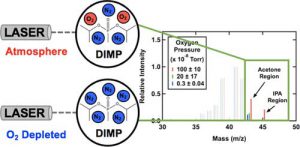1. Inquiry
HDIAC received the following technical inquiry from Dr. Gene Stark, JPM-P CBRN Protection:
“I am looking for reports from work done at Idaho National Labs (INL) using lasers to decompose VX nerve agent. My understanding is that INL used a neodymium-YAG [Neodymium-doped Yttrium Aluminum Garnet] laser at wavelength of 266 nm to decompose VX nerve agent on vinyl tile. Any reports you can find on using lasers to decompose chemical warfare agents would be helpful. Thank you very much [1].”
2. HDIAC Response
HDIAC analysts reached out to contacts at Idaho National Laboratory for reports completed by INL on the decomposition of VX and undertook a literature review using resources found in the Defense Technical Information Center (DTIC) Research & Engineering (R&E) Gateway as well as publicly available data. The results are provided in this report.
3. Background
Lasers can be used to decompose chemical nerve agents such as VX photochemically or photothermally.
“In photochemical decomposition, high-energy laser photons blast apart chemical bonds, slicing the agent into pieces. In photothermal decomposition, photons heat up the target surface enough to speed along natural degradation reactions. In some cases, the intense heat by itself can cause contaminant molecules to fall apart [2].”
4. Idaho National Laboratory
Dr. Bob Fox of Idaho National Laboratory initially led a series of tests at Dugway Proving Ground, UT. The bulk of the project was later transitioned to Edgewood Chemical Biological Center (ECBC) at Aberdeen Proving Ground, MD. The INL researchers used ultraviolet-wavelength lasers to scrub surfaces clean of sulfur mustard gas and VX, a nerve agent. The tests have proved successful, even on concrete [2]. According to an email exchange between HDIAC analyst Tara Barsotti and Idaho National Laboratory’s Dr. Bob Fox, the requested report on the project was classified and thus not publicly available. Dr. Fox discussed his personal experiences with “laser on VX that was spiked onto concrete, rubber escalator handrail, vinyl floor tile, painted wallboard, and a few other selected “urban” surfaces [3].” Dr. Bob Fox can be contacted at robert.fox@inl.gov and offered to further discuss his research with Dr. Gene Stark, JPM P CBRN Protection [3].
5. Other Reports of Chemical Agent Decomposition
Rapid laser heating has been used to decompose other chemical agents. A research project conducted by The James Franck Institute and Department of Chemistry at the University of Chicago showed that nerve agent simulant diisopropyl methylphosphonate (DIMP) could be destroyed with rapid laser heating under atmospheric conditions. Figure 1 shows the process of rapid laser heating.
“Following Nd:YAG laser ablation of liquid DIMP deposited on a graphite substrate, both parent and product fragments are transmitted via capillary from an atmospheric chamber to a vacuum chamber containing a high-resolution mass spectrometer. This allows for real-time measurements of product distributions under a variety of temperature and atmospheric conditions. Ex situ Fourier transform infrared (FTIR) spectroscopy analysis of the same chamber contents provides complementary information about product identities and fragmentation pathways. Results demonstrate that product distributions depend on heating rate, surface temperature, and atmospheric oxygen content [4].”

Figure 1: Laser Decomposition of DIMP.
6. Conclusion
HDIAC analysts were able to locate the report; however, it is recommended that Dr. Stark contact Dr. Fox directly (at the contact information found in Section 4) to obtain a copy of the report.
7. Literature Review
| Title/Corporate Author/Personal Authors |
Publish Date/ Call #/ Distribution |
| Proceedings for the Army Science Conference (24th) held on 29 November-2 December 2004 in Orlando, FL
Author(s): Kwon, Heesung, Nasrabadi, Nasser M., Lee, Wen-Hsiung, Gader, Paul D., Wilson, Joseph N., Weaver, Richard, Biship, Steven, Gugino, Peter, Howard, Peter, Sankaranayanan, Aswin C., Zheng, Qinfen, Chellappa, Rama, Cevher, Volkan, McClellan, James H., Qian, Ga Org: Assistant Secretary of the Army (Acquisition Logistics and Technology) |
12/01/2004
CBRNIAC-CB-027488 E- Distribution authorized to DoD Components |
| Development of Novel Decontamination Techniques for Chemical Agents (GB, VX, HD) Contaminated Facilities. Phase II. Laboratory Evaluation of Novel Agent Decontamination Concepts
Author(s): Zamejc, E. R., Mezey, E. J., Hayes, T. L., Wetzel, D. K., Garrett, B. C. Org: Battelle Columbus Division, OH |
06/21/1985
ADB093506 A- Approved for Public Release |
| Proceedings Of The 1985 Scientific Conference on Chemical Defense Research
Author(s): Rausa, Michael Org: Chemical Research and Development Center, Aberdeen Proving Ground, MD |
04/01/1986
ADB102344 C- Distribution authorized to U.S. Government agencies and their contractors |
| Issues for Sites Contaminated with Chemical, Biological, or Radiological Materials
Author(s): Not available Org: Environmental Protection Agency |
CBRNIAC-CB-089927
E- Distribution authorized to DoD Components |
| Chemical Warfare Agents and their Interactions with Solid Surfaces
Author(s): Gorzkowska-Sobas, Agnieszka, Anna Org: Norwegian Defence Research Establishment Kjeller |
03/01/2013
HDIAC-2055824 E- Distribution authorized to DoD Components |
| Enzymatic Bioremediation of Organophosphate Compounds-Progress and Remaining Challenges
Author(s): Thakur, Meghna, Medintz, Igor L., Walpher, Scott A. Org: Naval Research Lab, Washington, D.C. |
11/08/2020
AD1099768 A- Approved for Public Release |
| Technical Analysis Report for the Chemical, Biological, and Radiological (CBR) Contamination Survivability Assessment (CBRCSA) of the Small Tactical Optical Rifle Mounted Micro Laser Range Finder (STORM)II.
Author(s): Davila, Herbert Org: U.S. Army Dugway Proving Ground, UT |
05/20/2020
AD1097014 B- US Government Access Only |
References
[1] Stark, G. “HDIAC Technical Inquiry Submission.” Arlington, 2020.
[2] Department of Homeland Security Archived Content. “Laser Decontamination: Shine A Light,” Department of Homeland Security, 21 April 2010. [Online]. Available: https://www.dhs.gov/laser-decontamination#:~:text=Lasers%20can%20degrade%20weapons%20like,speed%20along%20natural%20degradation%20reactions, accessed June 2020.
[3] Fox, B. “Email between INL (B. Fox) and HDIAC (T. Barsotti).” Arlington, 2020.
[4] M. R. B. E. H. P. J. D. G. A. A. M. a. S. J. S. Rebecca S. Thompson. “Rapid Laser-Induced Temperature Jump Decomposition of the Nerve Agent Simulant Diisopropyl Methylphosphonate under Atmospheric Conditions.” Journal of Physical Chemistry, vol. 123, no. 35, pp. 21566-21570, 2019.


